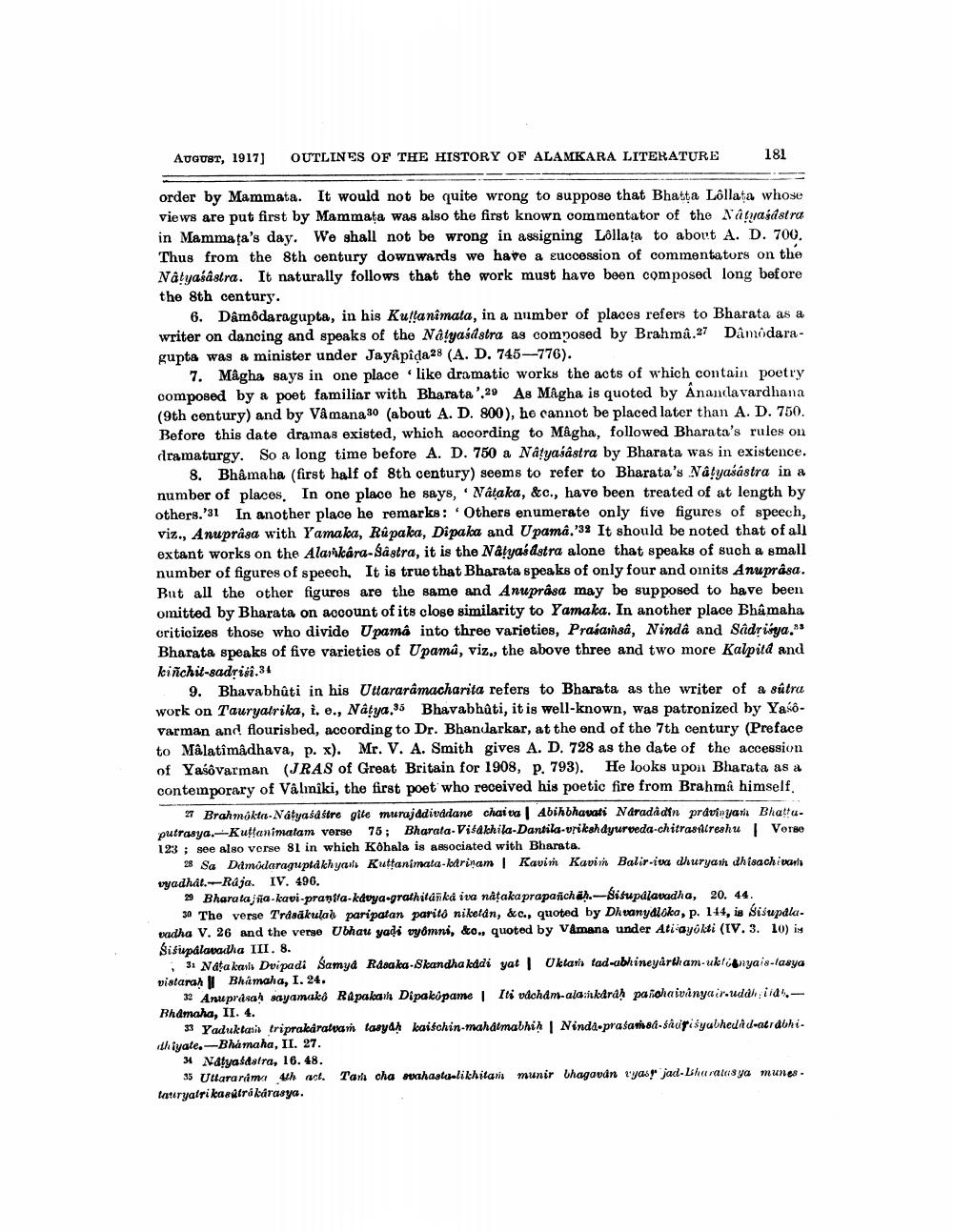________________
August, 1917)
OUTLINES OF THE HISTORY OF ALAMKARA LITERATURE
181
order by Mammata. It would not be quite wrong to suppose that Bhatta Lollata whose views are put first by Mammața was also the first known commentator of the Nâ grasastra in Mammata's day. We shall not be wrong in assigning Lollata to about A. D. 700. Thus from the 8th century downwards we have a succession of commentators on the Natyasastra. It naturally follows that the work must have been composed long before the 8th century.
6. Damodaragupta, in his Kultanimata, in a number of places refers to Bharata as a writer on dancing and speaks of the Natyaśdstra as composed by Brahma 27 Damodaragupta was a minister under Jay&pida28 (A. D. 745-776).
7. Mâgha says in one place like dramatic works the acts of which contain poetry composed by a poet familiar with Bharata'.29 As Magha is quoted by Ananclavardhana (9th century) and by Vâ mana 30 (about A. D. 800), he cannot be placed later than A. D. 750. Before this date dramas existed, which according to Mágha, followed Bharata's rules on dramaturgy. So a long time before A. D. 750 a Natyasastra by Bharata was in existence.
8. Bhâmaha (first half of 8th century) seems to refer to Bharata's Natyasástra in a number of places. In one place he says, "Nataka, &c., have been treated of at length by others.'31 In another place he remarks: Others enumerate only five figures of speech, viz., Anuprasa with Yamaka, Rúpaka, Dipaka and Upama.'39 It should be noted that of all extant works on the Alarkara-Sastra, it is the Natyaédstra alone that speaks of such a small number of figures of speech. It is true that Bharata speaks of only four and oinits Anuprasa. But all the other figures are the same and Anuprāsa may be supposed to have been omitted by Bharata on account of its close similarity to Yamaka. In another place Bhamaha criticizes those who divide Upama into three varieties, Prasarhsá, Ninda and Sadriya." Bharata speaks of five varieties of Upamû, viz., the above three and two more Kalpitd and kiñchit-sadis.34
9. Bhavabhūti in his Uttararamacharita refers to Bharata as the writer of a sútra work on Tauryatrika, i. e., Natya,35 Bhavabhậti, it is well-known, was patronized by Yaśô. varman and flourisbed, according to Dr. Bhandarkar, at the end of the 7th century (Preface to Malatîmâdhava, p. x). Mr. V. A. Smith gives A. D. 728 as the date of the accession of Yaśôvarman (JRAS of Great Britain for 1908, p. 793). He looks upon Bharata as a contemporary of Vâliniki, the first poet who received his poetic fire from Brahmi himself,
27 Brahmôkta-Natyasastre gite murajddivadlane chaina | Abihbhavati Narada din prdvinyaria Bhattu. putrasya.-Kuttanimatam vorse 75; Bharata. Visakhila-Dantila vrikahdyurveda-chitrasnlresh 4 | Vorge 123 ; see also verse 81 in which Kohala is associated with Bharata.
23 Sa Damodaraguptakhyal Kuttanimata-kariram Kavim Kavi Balir.iva dhuryan dhisachivan vyadhal.-Raja. IV. 496.
- Bharataj ia kavi pranila-kavya.grathilanka iva nataka prapafichi.-Sisuplavadha, 20. 44.
30 The verse Tråsäkulas paripatan parito niketan, &c., quoted by Dk vanydláka, p. 114, is Sisupalavadha V. 26 and the verge Ubhau yadi vyomni, &o.. quoted by Vamana under Ati ayokti (IV. 3. 10) is Sisupalavadha III. 8.
3. Nata kavi Dvipadi Samya Rasa ka-Skandha kddi yat 1 Uklam tad-ubhineyårt am uklidnyais-tasya vistarah | Bhamaha, I. 24.
32 Anuprasah sayamaki Rapakah Dipakúpame Iti odcham-alikdrah paislaivanya iruddh iidsBhamaha, II. 4.
33 Yaduktais triprakaratvam tasydh kaischin-mahátmabhih | Ninda-prasanissa-sacifisyubhedad-atrdikidhiyale.-Bhamaha, II. 27.
34 Nafyaśdstra, 16. 48.
35 Utararimi uh act. Ta cha puhastu-likhitaris munir bhagavdn tyas jad-Dhuratus ya munes. tatryatri kasutrákarasya.




